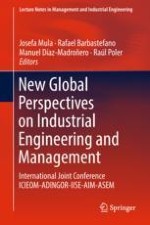This book presents the proceedings of the 3rd International Joint Conference – ICIEOM-ADINGOR-IISE-AIM-ASEM (IJC2017) “XXIII International Conference on Industrial Engineering and Operations Management”, “International ADINGOR Conference 2017”, “International IISE Conference 2017”, “International AIM Conference 2017” and “International ASEM Conference 2017”, which took place at UPV (Universitat Politècnica de València) from July 6th to 7th, 2017.
This joint conference is the result of an agreement between ABEPRO (Associação Brasileira de Engenharia de Produção), ADINGOR (Asociación para el Desarrollo de la Ingeniería de Organización), IISE (Institute of Industrial and Systems Engineers), AIM (European Academy for Industrial Management) and ASEM (American Society for Engineering Management).
Consisting of papers on new global perspectives on industrial engineering and management, the book offers an interdisciplinary view of industrial engineering and management. The topics covered include: strategy and entrepreneurship, quality and product management, modelling and simulation, knowledge and project management, logistics, as well as production, information and service systems.
